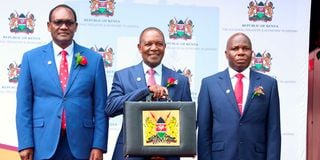Premium
Treasury needs additional Sh140bn to pay salaries, raising Kenya's debt burden

National Treasury and Economic Planning Cabinet Secretary Njuguna Ndung’u (Centre) with Treasury Principal Secretary Chris Kiptoo (left) and his Economic Planning counterpart James Muhati ahead of the 2023/2024 budget statement reading in Parliament on June 15, 2023.
What you need to know:
- More than 86 per cent of the additional spending will go to funding recurrent expenditure, which includes salaries.
- The recurrent spending will rise from Sh2.54 trillion approved by Parliament in June to Sh2.68 trillion
Kenyans will continue to bear huge economic burdens as President William Ruto backtracks on his spending plan for the current year, proposing to add recurrent spending this year by Sh140 billion.
This will see the government in 2023/24 borrow Sh864 billion, a Sh103 billion increase from the Sh761 billion Treasury had planned for in the current financial year and which was approved by Parliament.
Fresh data from Treasury reveals that the government now plans to increase the current financial year’s budget by Sh162 billion to Sh3.91 trillion. More than 86 per cent of the additional spending will go to funding recurrent expenditure, which includes salaries.
The recurrent spending will rise from Sh2.54 trillion approved by Parliament in June to Sh2.68 trillion.
“The resulting fiscal deficit inclusive of grants of Sh864 billion (5.4 per cent of GDP) will be financed by net external financing of Sh448.7 billion and net domestic financing of Sh415.3 billion,” Treasury states in the 2023 Budget Review and Outlook Paper.
The additional spending will only add to the burden taxpayers are carrying, amid increased taxes and others still being proposed, at a time many Kenyans are finding it hard to put food on the table as the cost of living bites. It is also a deviation from the fiscal consolidation strategy President Ruto has been strongly advocating in his speeches.
Further, the spending adds to the public debt burden Kenya is already facing as the fiscal deficit rises. A larger budget deficit means that the government has to borrow more money to fund its activities and, in this case, it wants to fund more recurrent activities, while releasing less than 14 per cent of the additional spending to development.
The revised spending plan has also seen the State walk back on a plan to trim domestic borrowing in the current financial year by 46 per cent to Sh316 billion, now targeting to borrow Sh415.3 billion from the local market. This poses more risks to businesses as banks are likely to deny them credit in favour of lending to government, which would constrain business activity and affect growth of jobs.
Already, businesses are feeling the heat on constrained lending from banks after the lending dipped by 8.5 per cent in July, following the Central Bank of Kenya’s move to raise the base lending rate to 10.5 per cent in June and Sh459 billion domestic borrowing by the government in 2022/23.
Raft of new taxes
The government, through the Medium-term Revenue Strategy for the period 2024/25 to 2026/27 has proposed a raft of new taxes, including Motor Vehicle Circulation Tax, reintroduction of minimum tax that will rope loss making companies into the tax man’s radar and the reintroduction of presumptive tax that targets the hard to tax micro, small and medium size enterprises.
This is on top of new taxes slapped on Kenyans since July, including the Housing Levy on employees and employers, increase of the Value Added Tax (VAT) on fuel to 16 per cent and the Digital Assets Tax at 3 per cent targeting traders of cryptocurrency starting this month.
The proposal to increase government spending comes even as the revenue collection for the first two months of the financial year fell below target by Sh58.7 billion.
“Budget implementation during the first two months of 2023/24 has progressed well. Total revenues amounted to Sh351.3 billion (2.2 per cent of GDP) in August 2023 against a target of Sh410 billion implying a performance rate of 85.6 per cent. There are expenditure pressures arising from 2022/23 carryovers amounting to Sh77.5 billion,” Treasury said.
It further said that the 5.4 per cent deficit is in line with its fiscal consolidation plan and is an improvement from the 5.6 per cent deficit in 2022/23.
“The implementation of FY 2023/24 budget has started in earnest. While the government has limited fiscal space, spending units are directed to ensure smooth implementation of planned programmes during the remainder of the financial year without accumulating any pending bills,” Treasury Cabinet Secretary Njuguna Ndung’u said.
Ordinary revenues
In 2023/24, the government projects to collect Sh2.57 trillion in ordinary revenues, but recurrent expenditures alone are more than this, at Sh2.68 trillion. President Ruto has often stated that his administration will not borrow to fund recurrent activities.
“Total revenues for the FY 2023/24 are projected at Sh3,002.5 billion (18.6 per cent GDP) with ordinary revenues projected at Sh2,571.4 billion (15.9 per cent of GDP). Total expenditures are projected at Sh3,908.7 billion (24.2 per cent of GDP),” Treasury stated.






